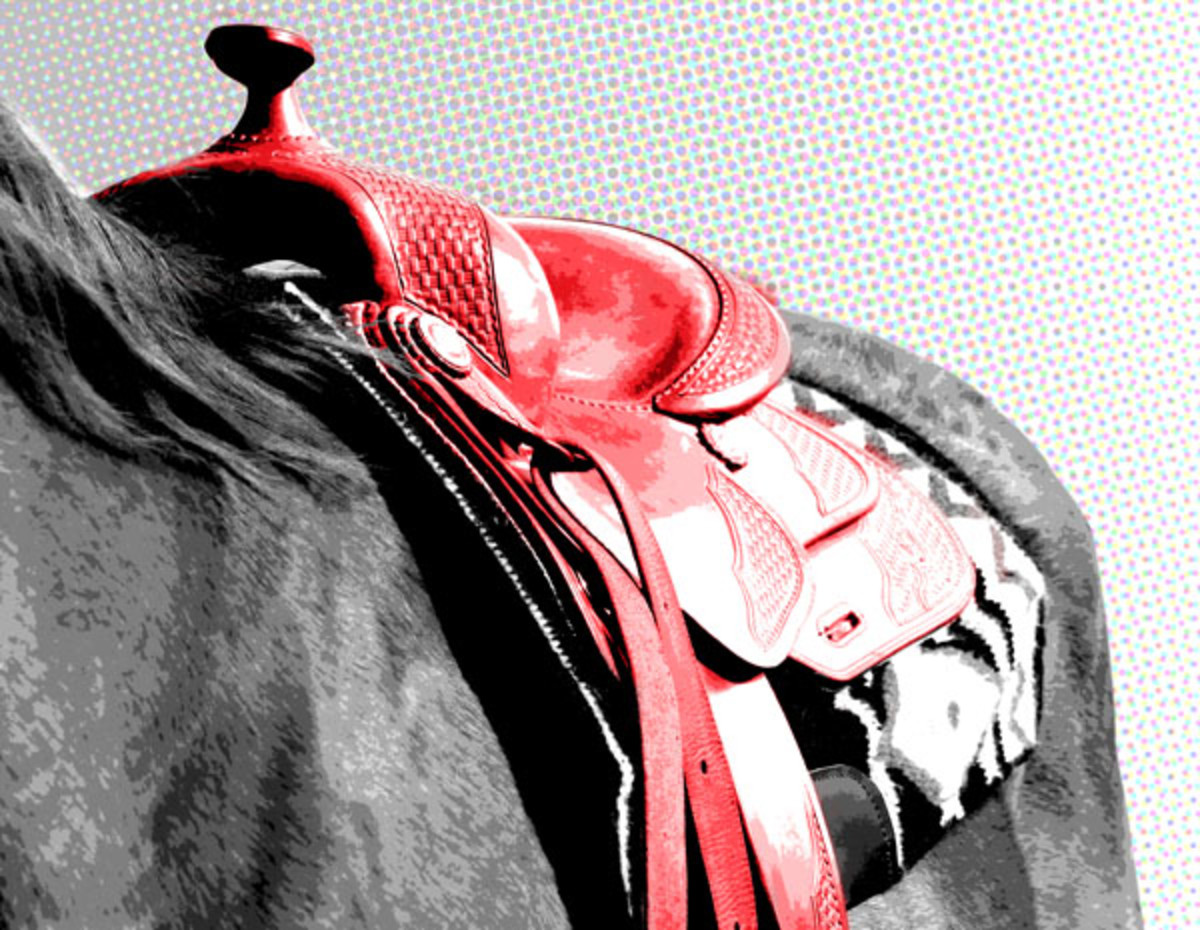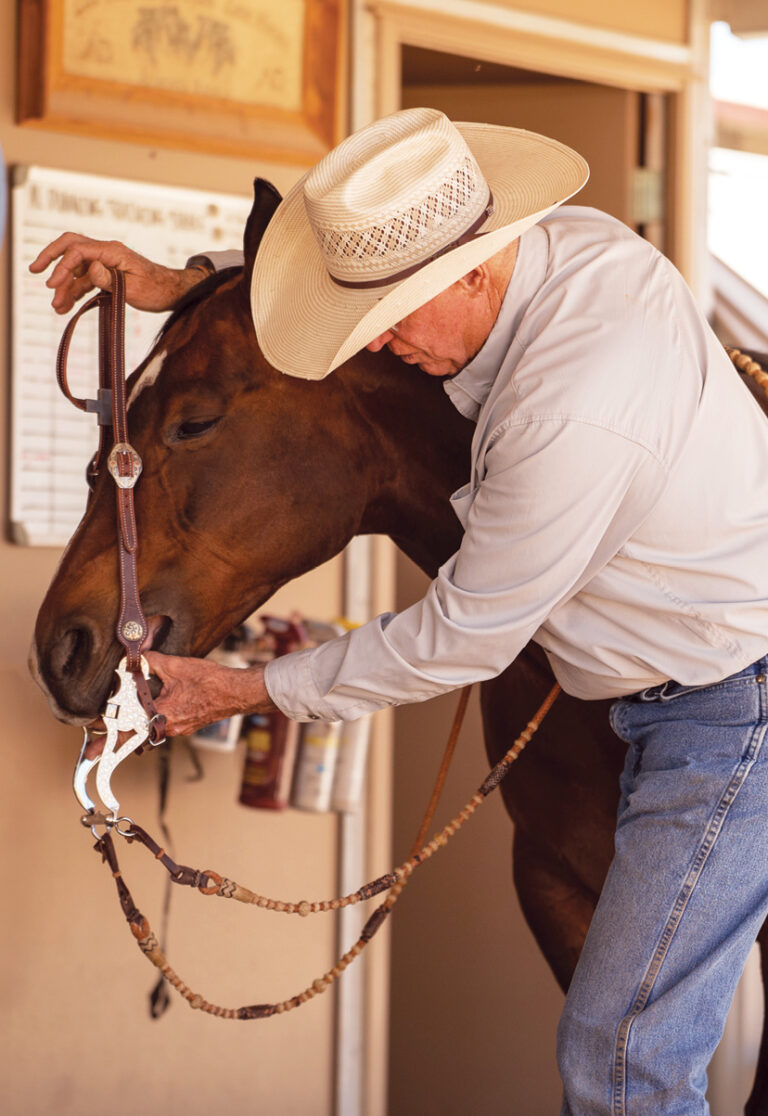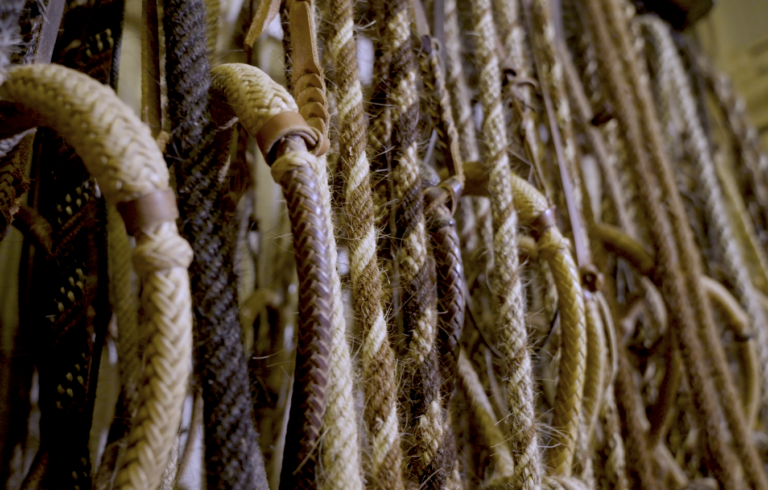When was the last time you broke in a pair of boots?

Did they rub your heels or pinch your toes? If so, you probably found a way to make it better—either with a well-placed moleskin or a pair of special socks. And chances are you didn’t just keep walking around the barn in them for hours on end.
Guess what? Your horse may be having the same problems with his saddle. It might be rubbing, pinching, or putting pressure on a sore spot. The difference is that he can’t make it better on his own. Your horse depends on you to see when he’s uncomfortable, and to do what it takes to make it better. That’s why it’s so important that you learn to recognize subtle signs of saddle-fit problems before they become severe.
[SHOP: Up Your Horse’s Comfort]
Relentless Black Orthopedic Gel Saddle Pad
Professional’s Choice Comfort Fit Tan
(As an Amazon Associate, we earn from qualifying purchases made through affiliate links.)
I’ll help you recognize seven common signs of saddle-fit trouble—from girth galls and pressure sores to bad behavior. I’ll tell you what to watch for; what to do when problems do occur; and most importantly, how you can prevent such issues in the first place.
Sign #1: Withers Swelling
What you see: A small, raised area on either side of your horse’s withers that shows up every time you ride, and that often disappears before you ride again. If you press firmly on the swelling, you can make a dent in the middle, as if you’re pressing on a firm loaf of bread dough. This swelling is edema, or fluid that’s accumulated under his skin. Although edema is most common on the withers, it’s also possible to see this type of swelling at any point along the edges of a horse’s spine. In more serious cases, these swellings will be hot and painful, and may not resolve completely between rides.
What it means: When you see edema on your horse’s withers after riding, chances are your saddle doesn’t fit him properly. A tree that’s too wide will sit too low in front, causing pressure on his withers. One that’s too narrow, or with a too-narrow gullet, will pinch and put pressure along the sides of his spine. If you don’t correct this problem soon, these pressure points can become very painful. They may even progress to open sores. Even if they don’t break open, the affected areas can experience pigment loss, leading to telltale patches of white hair.
Action: Check saddle fit. Ideally, you can find a saddle fitter in your area to help. If not, go to youtube.com, and find informative videos with a search for Western saddle fitting: proper way to fit a horse. Once you know that your tree size and gullet width are correct, avoid using pads that are too thick. A too-thick pad can cause pressure even with a properly fitted saddle, because you must cinch the saddle extra tight to keep the pad in place.
If the swelling is painful and persistent, avoid riding until it’s resolved, and ask your vet whether it might be advisable to treat the area with a topical anti-inflammatory medication (such as Surpass) to quiet it down.
Sign #2: Armpit Pinch
What you see: Patches of hair loss or crusty skin on his side, underneath the girth. In some cases, this area can develop a hot, painful, weepy sore—known in horseman’s circles as a “girth gall” or “cinch sore”—even after a single ride.
What it means: Your horse’s cinch is irritating his skin. Cinch sores can happen for a variety of reasons. It’s possible your saddle is sitting in an incorrect position on his back, causing his cinch to slip forward beneath his elbows where the skin is likely to get pinched. This problem is more common for some horses with conformation that lends itself to the cinch slipping forward. Your horse also may be sensitive to the material, or reactive to a piece of hardware or other design feature of the cinch.
[STOCK UP: Wound-Care Creams to Help Cinch Sores and Other Irritations]
Manna Pro Theracyn Equine Wound and Skin Care Spray
BANIXX Wound Care Cream with Moisturizing Marine Collagen
Farnam Wound Care for Horses, Dogs, Cattle and Ponies, Powder, Dressing and Protection
Action: If your horse develops a cinch sore, it’s crucial that you avoid riding him with a saddle until it’s healed completely. Keep the area clean, and treat it with a soothing ointment. Ask your vet whether an ointment containing a steroid might be recommended to help reduce inflammation in the area.
Check your saddle fit. If the saddle fits properly and it’s simply impossible to prevent the cinch from sliding forward, consider a cinch that’s designed with a curve to help minimize pressure and pinching under the elbows. Some horses are sensitive to neoprene; if you’re using a neoprene cinch, try leather instead. Rope cinches also can cause troubles for some horses, particularly if such cinches aren’t kept clean. A sheepskin-lined cinch or sheepskin cover is another good alternative for some sensitive horses. Once you’ve found a cinch that fits, keep it impeccably clean and well-maintained.
[SHOP: Comfort Cinches]
Sign #3: Dead Back
What you see: When you run your flat palm along our horse’s back, underneath where the saddle sits, you detect a flattened, “dead-feeling” area—most commonly located right under where you’d be centered in the seat of the saddle. Sometimes you can even see these flattened areas.
What it means: These dead zones often appear when pressure on the area causes decreased blood flow to the underlying tissues. It may mean your saddle isn’t fitting properly, although the issue can occur even with a well-fitted saddle.
Action: Check saddle fit. If your saddle fits properly, consider using a pressure-distributing pad to help minimize localized pressure on your horse’s back. But don’t make the mistake of simply adding extra layers of padding, as that will just make matters worse. It’s similar to adding an extra pair of socks when your shoes don’t fit.
Sign #4: Going Bald
What you see: Bald spots or patches of broken hair underneath your saddle.
What it means: Your saddle is rubbing against your horse’s skin, causing the hair to break. This can happen if your saddle doesn’t fit properly, and moves too much when your horse is working. These types of rubs can occur in almost any area, although they’re especially common under your seat. Isolated rubs also can appear if there’s a piece of loose leather or hardware, or if something is broken and rubbing against the horse’s skin.
Action: Check saddle fit. Find a pad that helps to hold it securely in place, even when your horse is working. For an isolated rub, check the area of your tack that’s in contact with that location on your horse’s skin, then fix anything that could be rubbing. If everything seems perfect with your saddle, consider a sheepskin pad directly against your horse’s skin. Sheepskin is an excellent choice for reducing friction, and really can help a sensitive horse. Bald spots and broken hair are early warning signs of trouble. As soon as you see them, take steps to correct the problem before they progress to open sores.
Sign #5: Bumpy Back
What you see: Look for hard nodules on your horse’s back. Just like dead spots and rubs, these nodules are most commonly seen under where you sit. They’re also common on either side of the withers. You may see them only on one side, especially if your horse is asymmetrical or you have a tendency to sit crookedly in the saddle. These hard nodules are rarely painful for your horse.
What it means: Nodules develop when there’s tissue death and scarring in the deep layers of tissue beneath your horse’s skin. Typically, they’re the result of a combination of pressure and friction.
Action: Check saddle fit. Consider a pad that combines pressure distribution and sheepskin to best protect your horse’s back. If the nodules are especially large, cutting a hole out of a pad that’s placed directly over the area can eliminate pressure on the nodule completely. Although these bumps may never disappear, they won’t continue to grow, and can even get much smaller over time if pressure is eliminated.
Sign #6: Ouch!
What you see: Your horse’s back is very painful when you run your hand along where the saddle sits. He may express his discomfort with pinned ears, snapping teeth, and a swishing tail when you place the saddle on his back.
What it means: Although this, too, can be related to saddle fit, it’s also possible that your horse has a primary back problem causing him pain. For example, a condition known as “kissing spines,” where the bony processes extending up from each vertebrae come in contact with one another, can cause this type of pain.
Action: Have your veterinarian check out your horse’s painful back. He might recommend radiographs to check for kissing spines, or medications to help relieve muscle spasms and pain. If no serious underlying cause can be identified, acupuncture might be recommended to help relieve pain. In addition, massage therapy or bodywork could be a part of your treatment plan.
[SHOP: Liniments to Aid Recovery]
Your vet is likely to recommend a plan that includes carrot stretches, belly lifts, or other manipulations that can help stretch and strengthen the muscles of your horse’s back. Of course, you should check your saddle fit, and make sure it’s appropriately padded to avoid localized pressure on your horse’s painful back. And your training and riding plan might have to be modified to help keep your horse comfortable over time.
Sign #7: Won’t Go
What you see: You mount up, ready for your ride. You’re ready to go, but your horse says “no!” He pins his ears, shakes his head, and refuses to move. When you push a little harder, he stands straight up on his hind legs or takes off bucking—depending on the day.
What it means: Behavior problems are a common sign of saddle pain. Pay attention when your horse first starts pinning his ears, refusing to go forward, or threatening to rear. If you don’t identify the source of his discomfort now, his behavior is likely to get worse and worse.
Action: Have your vet check your horse’s back for pain, and treat it as needed (see above). Check saddle fit carefully, and make sure the saddle is padded appropriately. If you believe these kinds of behavior problems have become a habit, find a good trainer who can help you work through your horse’s resistance while being sensitive to his discomfort.




